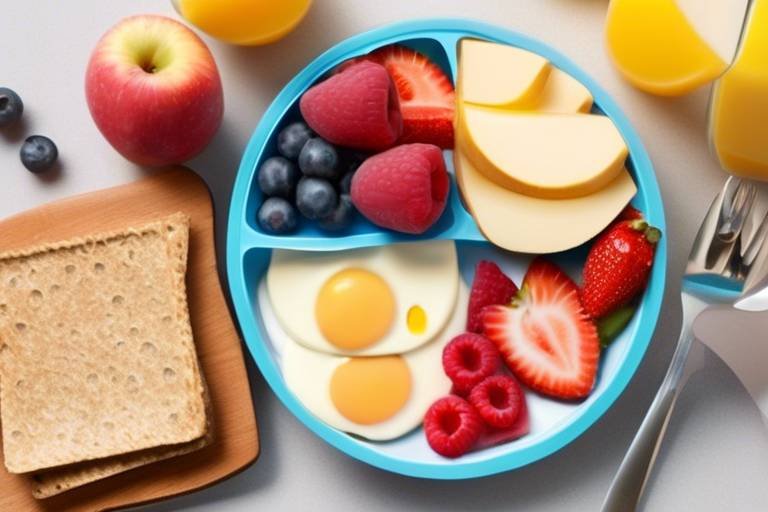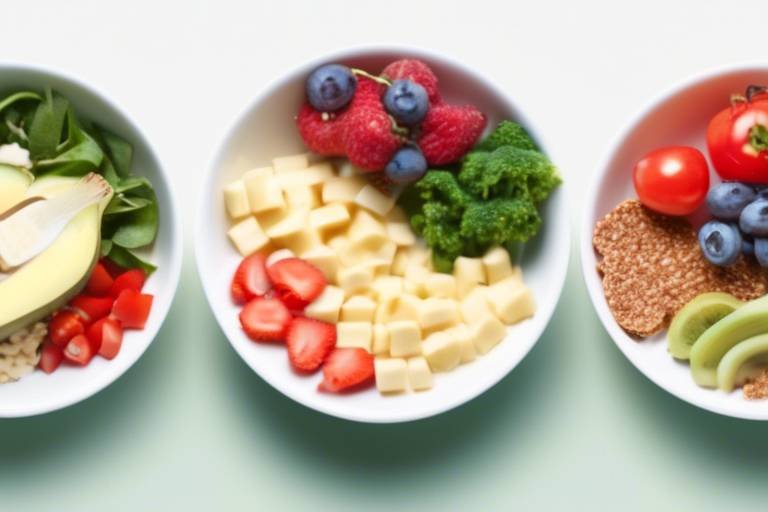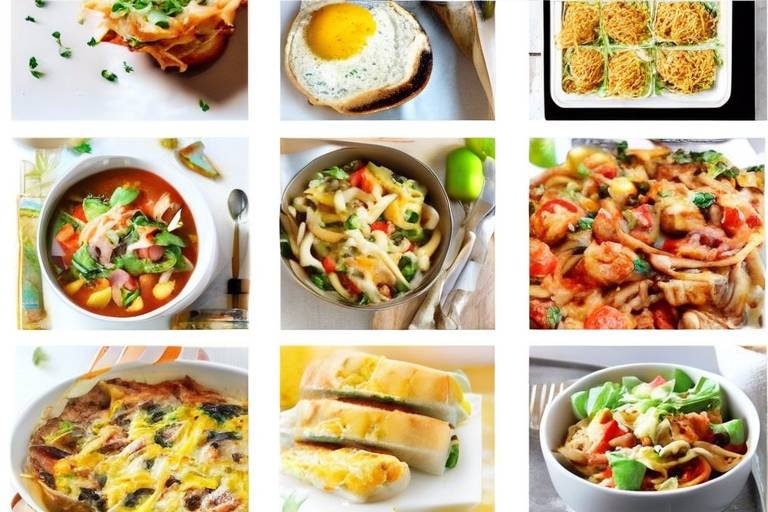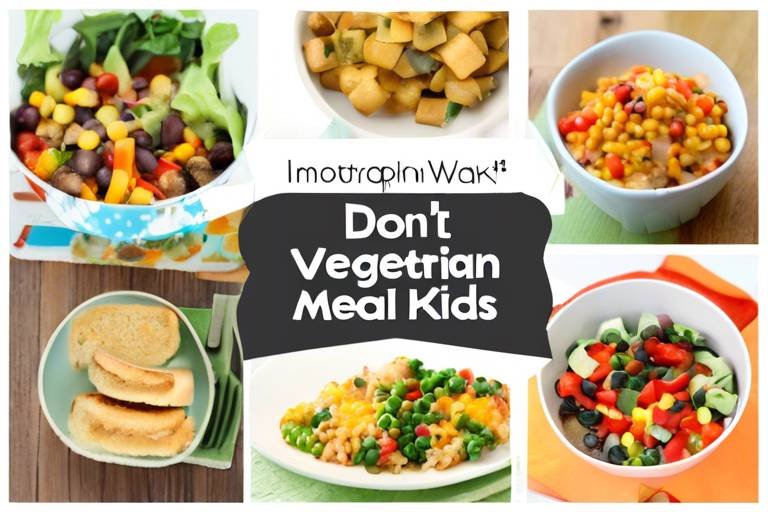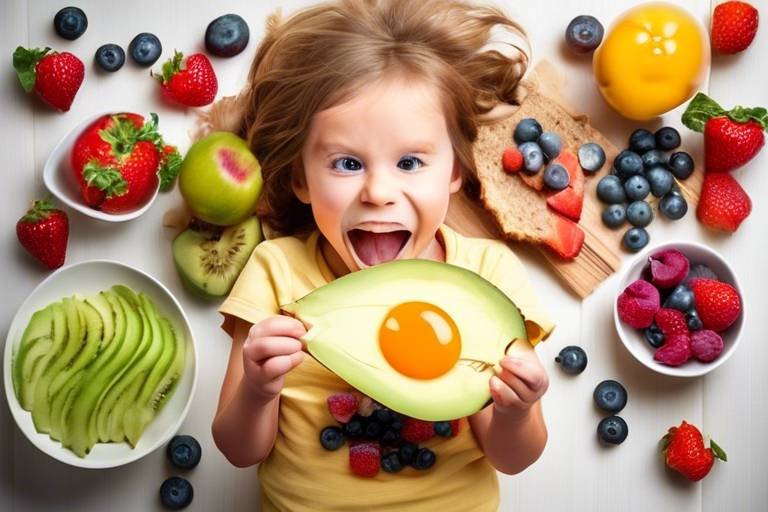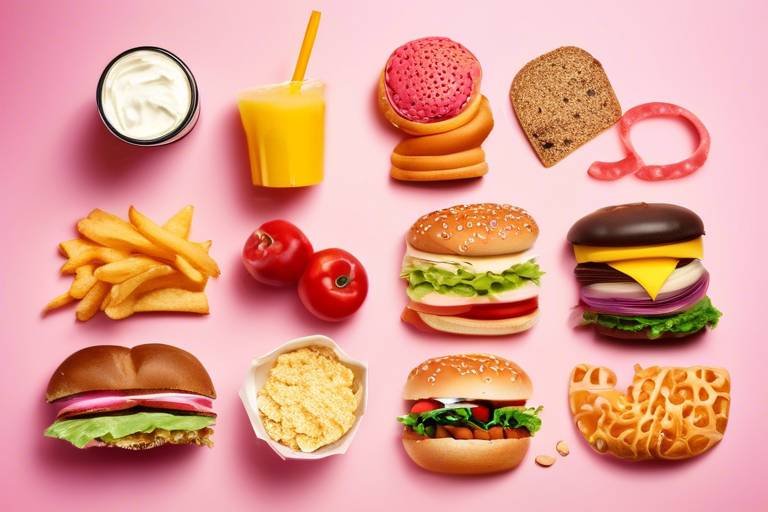Easy and Nutritious Snack Ideas for Toddlers
When it comes to feeding toddlers, the challenge is not just about nutrition but also about making snacks appealing and fun! Toddlers are at a stage where they are discovering flavors and textures, and as parents, we want to ensure that they are getting the right balance of nutrients while also enjoying their meals. This article explores a variety of simple and healthy snack options for toddlers, making mealtime enjoyable and nutritious while catering to their developing tastes and dietary needs.
Fresh fruits and vegetables are essential for toddlers, providing vital nutrients. However, let’s face it; getting toddlers to eat their greens can sometimes feel like pulling teeth! The trick is to present these foods in fun and appealing ways. Think of fruits as colorful paint on a blank canvas. You can create a rainbow plate with sliced strawberries, blueberries, and bananas, or turn veggies into fun shapes using cookie cutters. Not only does this make the food visually appealing, but it also sparks curiosity. Pair these with a dip, like hummus or yogurt, and watch your little one dive in! Remember, the goal is to make healthy eating a delightful adventure.
Whole grains are a great source of energy for active toddlers. They provide essential fiber and nutrients that help keep little tummies full and satisfied. Simple snacks like whole grain crackers or oatmeal can be transformed into exciting treats. For instance, try making mini whole grain pancakes topped with fresh fruit or a sprinkle of cinnamon. You can even create a fun trail mix using whole grain cereal, nuts (if there are no allergies), and dried fruits. This not only gives them energy but also teaches them about different textures and flavors. Who knew healthy could be so much fun?
Dairy products are packed with calcium and protein, essential for your toddler's growth. But how can you make dairy exciting? Explore creative ways to include yogurt, cheese, and milk in your toddler's snacks. For example, try making yogurt parfaits with layers of yogurt, granola, and fruits. This not only looks appealing but also provides a balance of nutrients. Cheese can be fun too; think cheese sticks shaped like animals or cheese cubes with toothpicks for easy picking. And don't forget about smoothies! Blend yogurt with fruits and a splash of milk for a tasty treat that feels like dessert but is loaded with goodness.
Protein is crucial for a toddler's growth and development. Snacks that are rich in protein will keep your little one satisfied and energized throughout the day. Consider options like hard-boiled eggs, nut butters (if allergies permit), and legumes. For example, you can make a simple egg salad that toddlers can enjoy on whole grain bread or crackers. Alternatively, try making energy bites with oats, nut butter, and honey—perfect for a quick snack that packs a protein punch! The key is to keep it simple and creative, turning every snack into an opportunity for your child to explore new tastes.
Dips can make snacks more enjoyable for toddlers, turning ordinary fruits and veggies into a fun experience. Why not whip up some nutritious dip recipes that pair well with your toddler's favorite snacks? Hummus, guacamole, or even a simple yogurt dip can encourage your child to try new flavors. Imagine a colorful platter of carrot sticks, cucumber rounds, and apple slices, all waiting to be dunked into a delicious dip. Not only does this make eating more interactive, but it also helps toddlers experiment with different tastes and textures.
We all know toddlers have a sweet tooth, but satisfying that craving doesn’t have to mean indulging in sugary snacks. There are plenty of healthier alternatives that can satisfy their desire for sweetness. Consider making banana pancakes, energy balls made from dates and nuts, or fruit popsicles. These naturally sweet snacks are not only delicious but also nutritious. You can even involve your toddler in the preparation process, making it a fun family activity. After all, who wouldn’t want to enjoy a sweet treat that’s good for them?
Preparing snacks in advance can save time and ensure healthy options are always available. Here are some practical tips for efficient snack preparation for busy parents:
- Plan your snacks for the week ahead, making a shopping list of necessary ingredients.
- Set aside a specific time each week to prepare snacks. This could be on a Sunday afternoon or any day that works for you.
- Use clear containers to store prepped snacks in the fridge, making it easy for your toddler to grab and go.
By integrating these simple strategies, you’ll not only save time but also encourage your toddler to make healthier choices independently.
For toddlers with food allergies, finding safe snack options is essential. It can be a bit tricky, but there are plenty of allergy-friendly snack ideas that cater to various dietary restrictions without compromising on taste. Consider making snacks like rice cakes topped with avocado, homemade fruit leather, or energy bites made from seeds and oats. Always check labels and be mindful of cross-contamination, ensuring that your snacks are safe for your child. With a little creativity, you can whip up delicious treats that everyone can enjoy!
Getting toddlers involved in snack preparation can make them more excited about eating. It’s like inviting them to be little chefs in the kitchen! You can start by letting them wash fruits and veggies, measure ingredients, or even help with simple mixing tasks. Not only does this foster a sense of independence, but it also teaches them valuable skills. Plus, when they’ve had a hand in making their snacks, they’re more likely to try them! Turn snack time into a fun learning experience, and watch as their curiosity grows along with their appetite.
1. What are some quick snack ideas for toddlers?
Some quick snack ideas include sliced fruits, yogurt with granola, whole grain crackers with cheese, or veggie sticks with hummus. These options are not only nutritious but also easy to prepare!
2. How can I make healthy snacks more appealing to my toddler?
Try using colorful plates, fun shapes, and interactive elements like dips to make healthy snacks more appealing. Presentation can make a big difference in how toddlers perceive their food!
3. Are there any allergen-free snack options?
Yes! Options like rice cakes, fruit smoothies, and homemade energy bites made from seeds can be great allergen-free snacks. Always check for specific allergies and adapt recipes accordingly.
4. How can I get my toddler to try new foods?
Involve them in the cooking process, offer small tastes, and be patient. Sometimes it takes a few tries before they warm up to new flavors.

Fruits and Vegetables
Fresh fruits and vegetables are not just colorful additions to your toddler's plate; they are essential building blocks for a healthy diet. Packed with vital nutrients, these foods help fuel your little one’s growth and development. However, getting toddlers to eat their greens and fruits can sometimes feel like a Herculean task. The key is in the presentation! By transforming these healthy foods into fun and appealing snacks, you can encourage your child to embrace a variety of flavors and textures.
One effective way to make fruits and vegetables more enticing is by creating a vibrant snack platter. Picture this: a rainbow of fruits like juicy strawberries, sweet bananas, and crunchy carrots arranged in a fun shape, perhaps resembling a smiley face or a flower. Not only does this make the snack visually appealing, but it also invites curiosity and excitement. You can even involve your toddler in the process of arranging the platter, turning snack time into a creative activity.
Another fantastic idea is to introduce fruit and vegetable skewers. By threading pieces of fruits and veggies onto colorful sticks, you create a portable snack that's easy for tiny hands to hold. Imagine a skewer with alternating chunks of grapes, cucumber, and cheese—a delightful combination that’s both nutritious and fun to eat. You might be surprised at how quickly your toddler will devour these wholesome treats when they're presented in such a playful manner.
To further enhance the appeal, consider serving fruits and vegetables with healthy dips. For example, a creamy yogurt dip can transform plain apple slices into a delightful treat. Similarly, hummus can make carrot sticks irresistible. These dips not only add flavor but also introduce new textures and tastes, encouraging your toddler to explore their palate.
Here are some quick tips to keep in mind when preparing fruits and vegetables for your toddler:
- Variety is Key: Offer a mix of colors and types to keep things interesting.
- Cut into Fun Shapes: Use cookie cutters to create fun shapes that will intrigue your child.
- Incorporate Them into Meals: Blend fruits into smoothies or add veggies to omelets to sneak in those nutrients.
Ultimately, the goal is to create a positive snacking experience that encourages healthy eating habits. By presenting fruits and vegetables in exciting ways, you can help your toddler develop a love for these nutritious foods that lasts a lifetime. Remember, the more fun and interactive you make it, the more likely your little one will be to indulge in these healthy snacks!

Whole Grains
Whole grains are a fantastic source of energy for our little bundles of joy, and they play a crucial role in their overall growth and development. Think of whole grains as the sturdy building blocks that support your toddler's active lifestyle. They provide essential nutrients like fiber, vitamins, and minerals, all while being deliciously versatile. But how do you introduce these healthy grains into your toddler's diet? Let’s explore some easy and fun ways to incorporate them into their snacks!
One of the simplest ways to include whole grains in your toddler's snacks is to opt for whole grain bread or crackers. Imagine a delightful, crunchy cracker topped with a smear of nut butter—it's not just a treat; it's a powerhouse of nutrition! You can also create mini sandwiches using whole grain bread, filled with their favorite ingredients. For instance, a slice of whole grain bread with mashed avocado and a sprinkle of cheese can be a hit. Why not make it fun? Use cookie cutters to shape the sandwiches into stars or hearts, making snack time a delightful experience for your little one!
Another great option is to introduce whole grain cereals. Look for cereals that are low in sugar and high in fiber. You can serve them with milk or yogurt, adding some fresh fruits on top for a burst of flavor and color. Not only does this combination make for a nutritious snack, but it also turns breakfast into a fun and interactive meal. Your toddler can help sprinkle the fruits on top, making them feel involved in the kitchen.
If you're feeling a bit adventurous, consider making whole grain pancakes or waffles. These can be prepared in batches and frozen for later use. Just pop them in the toaster when your toddler is craving a snack! You can even add mashed bananas or pumpkin puree to the batter for an extra nutritional boost. The best part? They can be served with a drizzle of honey or a dollop of yogurt, transforming a simple snack into a delightful treat.
For a crunchy snack option, try making popcorn using whole grain kernels. Popcorn is not only fun to eat but also a whole grain snack that can be customized in countless ways. You can sprinkle it with a little cheese powder, cinnamon, or even a touch of cocoa for a sweet treat. Just be sure to supervise your toddler while they munch on popcorn, as it can be a choking hazard.
Lastly, don’t overlook the power of oats! Oatmeal isn’t just for breakfast; it can be a fantastic snack too. You can make energy balls by mixing rolled oats with nut butter, honey, and a few chocolate chips or dried fruits. Roll them into small balls, and you’ve got a nutritious, grab-and-go snack that your toddler will love. They’re perfect for busy days when you need something quick and healthy!
Incorporating whole grains into your toddler's diet doesn’t have to be a chore. With a little creativity and fun, you can turn healthy eating into an enjoyable adventure. Remember, the key is to make these snacks appealing and interactive. By doing so, you’re not only nourishing their bodies but also instilling healthy eating habits that can last a lifetime.
Q: What are some easy whole grain snack ideas for toddlers?
A: Some easy whole grain snack ideas include whole grain crackers with nut butter, mini sandwiches made with whole grain bread, whole grain cereals with milk, pancakes or waffles made from whole grain flour, and homemade energy balls with oats.
Q: How can I make whole grains appealing to my toddler?
A: Making whole grains appealing can be as simple as using fun shapes with cookie cutters, adding colorful fruits, or involving your toddler in the preparation process. The more engaged they are, the more likely they are to enjoy their snacks!
Q: Are whole grains safe for toddlers with allergies?
A: Most whole grains are safe, but always check for specific allergies. If your toddler has a gluten intolerance, opt for gluten-free whole grains like quinoa or brown rice.

Dairy Delights
Dairy products are not just delicious; they are also packed with essential nutrients that are crucial for your toddler's growth and development. Think of dairy as a superhero in your child's diet, providing calcium for strong bones, protein for muscle development, and a host of other vitamins that contribute to overall health. But how do you make dairy appealing to a picky toddler? Let's dive into some creative ways to incorporate these dairy delights into your little one’s snack time!
First up, we have yogurt—a versatile snack that can be enjoyed in many ways. You can serve it plain or add a splash of honey (for toddlers over one year old) or mix in some fresh fruits for a burst of flavor. Consider making yogurt parfaits by layering yogurt with granola and fruits in a cup. Not only does it look visually appealing, but it also turns snack time into a fun, interactive experience. Your toddler can even help you layer the ingredients, turning them into a little chef!
Another dairy delight is cheese, which comes in various forms and flavors. Cheese sticks, cubes, or slices can be an easy grab-and-go snack that toddlers love. You could also try making cheesy quesadillas with whole grain tortillas. Just sprinkle some cheese inside, fold it over, and heat it up until the cheese melts. Cut it into fun shapes with cookie cutters, and watch your child’s eyes light up! The gooey cheese combined with the crispy tortilla makes for a delightful snack that’s hard to resist.
Milk is another fantastic option, but let’s think outside the box. Instead of just serving a glass of milk, how about making smoothies? Blend together some milk, a banana, and a handful of spinach for a nutrient-packed green smoothie that’s surprisingly sweet and creamy. You can even add a spoonful of peanut butter for an extra protein boost. Smoothies are a great way to sneak in some extra fruits and veggies without your toddler even noticing!
Now, let’s not forget about the wonderful world of cottage cheese. This creamy delight is rich in protein and can be served in various ways. Try mixing it with diced fruits for a refreshing snack, or pair it with whole grain crackers for a crunchy contrast. You can even use it as a topping for pancakes or waffles, turning an ordinary meal into something extraordinary!
To wrap it up, dairy products offer a treasure trove of nutritional benefits and can be transformed into fun and exciting snacks for toddlers. The key is to get creative and present these foods in ways that spark your child's interest. Remember, the more involved they are in choosing and preparing their snacks, the more likely they are to enjoy them!
Q: How much dairy should my toddler consume daily?
A: The American Academy of Pediatrics recommends that toddlers aged 1-3 consume about 2 cups of dairy per day, which can include milk, yogurt, and cheese.
Q: What if my toddler is lactose intolerant?
A: If your toddler is lactose intolerant, you can consider lactose-free milk and dairy products or explore alternatives like almond or soy milk, ensuring they are fortified with calcium and vitamin D.
Q: How can I make dairy snacks more appealing?
A: Try to get creative with presentation! Use fun shapes, colorful fruits, and let your toddler help in the kitchen. Engaging them in the process can make them more excited about trying new foods.

Protein-Packed Options
When it comes to fueling your toddler's growth and development, protein plays a vital role. It’s not just about filling their tummies; it’s about providing them with the building blocks they need for strong muscles and healthy development. Think of protein as the bricks in the house of your child's growth—without them, the structure just can't stand tall! So, what are some delicious and easy ways to incorporate protein into your toddler's snacks? Let’s dive into some tasty options that will keep those little energy levels soaring!
One of the simplest ways to add protein to your toddler's diet is through eggs. Scrambled, boiled, or even made into mini omelets, eggs are incredibly versatile and can be served in numerous ways. For a fun twist, try making egg muffins by whisking eggs with veggies and cheese, pouring them into muffin tins, and baking until fluffy. These bite-sized wonders are not only packed with protein but also easy for little hands to grab and enjoy!
Nut butters are another fantastic option. Whether it's peanut butter, almond butter, or sunflower seed butter, these spreads are rich in protein and healthy fats. Spread them on whole grain toast, mix them into smoothies, or serve them as a dip for apple slices or celery sticks. Just remember to check for any allergies before introducing nut butters into your toddler's diet. It’s like giving them a little hug of nutrition in every bite!
Legumes, such as chickpeas, black beans, and lentils, are also protein powerhouses. You can whip up some delicious hummus by blending chickpeas with tahini, lemon juice, and garlic. This creamy dip pairs perfectly with fresh veggies or whole grain pita bread, making snack time both fun and nutritious. Plus, legumes are packed with fiber, which helps keep those little tummies full and happy!
For an extra protein boost, consider incorporating dairy products into your toddler's snacks. Yogurt is not only a great source of calcium but also contains protein. Opt for plain yogurt and add your own fruits or a drizzle of honey for sweetness. This way, you can control the sugar content while still delivering a tasty treat. You can even freeze yogurt into popsicles for a refreshing snack on a hot day!
Here’s a quick overview of some protein-packed snack options for your toddler:
| Snack | Protein Source | Serving Idea |
|---|---|---|
| Egg Muffins | Eggs | Mini muffins with veggies and cheese |
| Nut Butter Toast | Nut Butters | Spread on whole grain toast with banana slices |
| Hummus | Chickpeas | Served with carrot sticks or pita |
| Yogurt Parfait | Yogurt | Layered with fruits and granola |
Incorporating these protein-packed options into your toddler's diet is not just about nutrition; it’s about making snack time an enjoyable experience. By presenting these snacks in fun and engaging ways, you can help foster a positive relationship with food. Remember, the goal is to make healthy eating a delightful adventure for your little one, and with these protein-rich ideas, you’re well on your way!
Q: How much protein does my toddler need daily?
A: Generally, toddlers need about 13-19 grams of protein a day, depending on their age and activity level. It's best to spread this intake across meals and snacks.
Q: Are there any nut-free alternatives to nut butters?
A: Yes! You can use sunbutter (made from sunflower seeds) or soy nut butter as great alternatives for those with nut allergies.
Q: How can I encourage my toddler to try new protein-rich foods?
A: Make it fun! Involve them in the kitchen, let them choose toppings for their yogurt, or create colorful plates to spark their interest in new foods.

Healthy Dips
When it comes to making snacks exciting for toddlers, can be a game changer. Dips not only add flavor but also make eating fruits and vegetables more enjoyable. Imagine your little one eagerly reaching for carrot sticks or apple slices, all because they’re paired with a delicious dip! The right dips can turn ordinary snacks into something extraordinary, and they’re a fantastic way to sneak in extra nutrients. Here are some ideas to get you started.
One of the simplest and most beloved dips is hummus. Made primarily from chickpeas, hummus is not only creamy and delicious but also packed with protein and fiber. You can easily customize it by adding flavors like roasted garlic, red pepper, or even a hint of lemon for that zesty kick. Serve it with a variety of dippable options such as cucumber slices, bell pepper strips, or whole grain pita bread. Your toddler will love the chance to dip and discover new tastes!
Another fantastic option is yogurt-based dips. These can be as simple as mixing plain yogurt with a bit of honey and cinnamon or creating a savory version with herbs and spices. Yogurt is a great source of calcium and protein, making it a nutritious choice. You can even blend in some fruit for a sweet twist. For example, a strawberry yogurt dip can be a delightful accompaniment to fresh fruit skewers, making snack time feel like a fun adventure.
If you’re looking for something with a little more zest, consider making a guacamole dip. Avocados are loaded with healthy fats, which are essential for your toddler’s growth and development. Simply mash ripe avocados and mix in some lime juice, diced tomatoes, and a pinch of salt. Serve it with whole grain tortilla chips or veggie sticks, and watch as your little one dives in with excitement!
To make things even more fun, you can create a dipping platter. Arrange a variety of dips alongside colorful fruits and veggies, and let your toddler choose what they want to try. This not only encourages them to explore different flavors but also gives them a sense of independence in their eating choices. Here’s a quick overview of some healthy dip ideas:
| Dip | Main Ingredient | Nutrition Highlights |
|---|---|---|
| Hummus | Chickpeas | High in protein and fiber |
| Yogurt Dip | Plain Yogurt | Rich in calcium and probiotics |
| Guacamole | Avocado | Loaded with healthy fats |
Don’t forget that dips can also be a great way to introduce new flavors to your toddler's palate. If they’re hesitant about certain vegetables, pairing them with a tasty dip can ease their apprehension. It’s all about making healthy eating fun and engaging. So, get creative in the kitchen and experiment with different combinations. Your toddler might surprise you with their adventurous taste buds!
In summary, healthy dips are an excellent way to enhance snack time for toddlers. They provide a delicious way to incorporate more fruits and vegetables into their diets while also making mealtime enjoyable. Whether it’s hummus, yogurt dips, or guacamole, these options are sure to please even the pickiest eaters. So, roll up your sleeves and start dipping!
Q: What are some easy dips to make for toddlers?
A: Easy dips include hummus, yogurt-based dips, and guacamole. These can be made quickly with minimal ingredients and are packed with nutrition!
Q: How can I encourage my toddler to try new vegetables?
A: Pairing new vegetables with fun and tasty dips can encourage your toddler to try them. Make it a game by letting them choose which dip to use!
Q: Are there any dips that are allergy-friendly?
A: Yes! Many dips can be made without common allergens. For instance, hummus is typically free from dairy and gluten, making it a safe choice for many children.

Sweet Treat Alternatives
Satisfying a toddler's sweet tooth can feel like a daunting task, especially when you want to keep their diet healthy and nutritious. But don't worry! There are plenty of delicious and wholesome alternatives to traditional sweets that will keep your little ones happy without compromising their health. Imagine replacing sugary candies and cookies with treats that not only taste great but also provide essential nutrients. Sounds like a win-win, right?
One of the best ways to create sweet alternatives is by incorporating naturally sweet ingredients. Fruits are a fantastic choice! Think about the vibrant colors and flavors of fruits like bananas, apples, and berries. You can turn these into fun snacks by making fruit kabobs or smoothies. For instance, a banana cut into slices and spread with a little nut butter can be a delightful treat. Not only does it satisfy their cravings, but it also packs in healthy fats and protein!
Another excellent option is to make homemade energy balls. These little bites of goodness are incredibly easy to prepare and can be customized to your toddler's taste. Combine oats, nut butter, honey, and your choice of add-ins like chocolate chips or dried fruits. Roll them into small balls and refrigerate. You’ll have a quick, nutritious snack that feels like a treat! Here’s a simple recipe:
| Ingredients | Measurements |
|---|---|
| Rolled oats | 1 cup |
| Nut butter (peanut, almond, or sunflower) | 1/2 cup |
| Honey or maple syrup | 1/3 cup |
| Chocolate chips or dried fruit | 1/4 cup (optional) |
Mix all the ingredients in a bowl, roll them into small balls, and voila! You have a sweet treat that’s also packed with energy. You can store these in the fridge for a quick grab-and-go snack.
If you're looking for something a bit more indulgent, consider making yogurt parfaits. Layering yogurt with fresh fruits and a sprinkle of granola can create a visually appealing and nutritious dessert. Not only does this provide protein from the yogurt, but the fruits add vitamins and the granola gives a satisfying crunch. Plus, you can let your toddler help assemble their parfait, making it an interactive experience!
Finally, let’s not forget about baked goods. You can whip up some healthy muffins or cookies using whole grain flour, mashed bananas, or applesauce for sweetness. These alternatives can be just as delicious as their sugary counterparts! Imagine the joy on your toddler's face when they see a fresh batch of banana oatmeal cookies cooling on the counter.
In conclusion, providing sweet treat alternatives for your toddlers doesn’t have to be a challenge. By using natural ingredients and getting creative in the kitchen, you can whip up snacks that are not only enjoyable but also nutritious. So, the next time your little one asks for something sweet, you’ll be prepared with a variety of healthy options that are sure to please!
- What are some easy ways to make fruits more appealing to toddlers? Try cutting fruits into fun shapes or creating fruit skewers. Dipping fruits in yogurt or nut butter can also make them more enticing.
- Are there any good substitutes for sugar in baking? Yes! You can use mashed bananas, applesauce, or honey as natural sweeteners in many recipes.
- How can I involve my toddler in snack preparation? Let them help with simple tasks like mixing ingredients or assembling their own yogurt parfaits. It makes them more excited about eating!

Snack Prep Tips
Preparing snacks for toddlers can sometimes feel like a daunting task, especially when you’re juggling a million other responsibilities. But fear not! With a little planning and creativity, you can turn snack prep into a breeze. The key is to stay organized and make the most of your time in the kitchen. Start by dedicating a specific day each week for snack preparation. This way, you can whip up a variety of healthy options that are ready to grab when hunger strikes. Think of it as setting up a snack station in your home!
One effective strategy is to create a snack prep station in your kitchen. Stock it with containers, cutting boards, and utensils dedicated solely to snack preparation. You might want to use clear containers to store pre-cut fruits and veggies so that they’re easily visible and accessible. Kids are naturally drawn to colorful foods, so presenting them in a fun way can make all the difference. For example, you can create a rainbow of fruits and vegetables that not only looks appealing but also encourages your toddler to try new things!
Another helpful tip is to involve your little ones in the process. Children love to help, and when they participate in making their snacks, they’re more likely to eat what they’ve created. Simple tasks like washing fruits, mixing ingredients, or arranging snacks on a plate can be both fun and educational. Plus, it’s a great opportunity to teach them about healthy eating habits. You can even turn it into a mini cooking class, where you explain the benefits of each ingredient as you go along.
When it comes to storing snacks, consider using portion control containers or snack bags. This not only helps with serving sizes but also makes it easy for your toddler to grab their own snacks independently. You can prepare a variety of snacks in advance and store them in the fridge or pantry. For instance, you could make a batch of whole grain muffins or energy balls and keep them on hand for a quick grab-and-go option. It’s all about making healthy choices easy!
Lastly, don’t forget to rotate your snacks regularly to keep things exciting. Just like adults, toddlers can get bored with the same old snacks day in and day out. Introduce new flavors and textures to keep their taste buds engaged. You might even want to create a snack calendar that lists different snacks for each day of the week. This not only adds variety but also gives your toddler something to look forward to. Who knew snack prep could be so much fun?
- How can I make healthy snacks more appealing to my toddler? Try using fun shapes, bright colors, and creative presentations. For example, cut fruits into fun shapes with cookie cutters or arrange veggies in a rainbow.
- What are some quick snacks I can prepare on busy days? Consider options like yogurt parfaits, fruit smoothies, or whole grain toast with nut butter. These can be made in just a few minutes!
- How do I store snacks to keep them fresh? Use airtight containers and keep them in the fridge or a cool pantry. Portioning them out can also help maintain freshness.

Allergy-Friendly Snacks
When it comes to feeding toddlers, ensuring their snacks are both delicious and safe can be a daunting task, especially for parents navigating food allergies. With the rise of dietary restrictions, it's crucial to explore allergy-friendly snack options that cater to various needs without sacrificing flavor. Whether your little one is allergic to nuts, dairy, or gluten, there are plenty of creative and nutritious snacks to keep their taste buds happy and their bellies full.
First, let’s talk about fruits and vegetables. These naturally allergy-friendly options can be served in numerous ways. For instance, you can create a vibrant fruit salad by combining apples, bananas, and berries, or serve crunchy carrot sticks with a tasty dip. Not only are these snacks packed with vitamins, but they also introduce your toddler to a variety of textures and flavors. You can even get artistic by arranging the fruits and vegetables into fun shapes or characters to make them more appealing.
Next up are whole grains, which are generally safe for most toddlers and provide essential energy. Think about making some homemade popcorn (without butter) or rice cakes topped with avocado or hummus. These snacks are not only filling but also help in developing healthy eating habits early on. Whole grains can be a great canvas for flavors, so don’t hesitate to experiment with different toppings and spreads that suit your child’s dietary restrictions.
For those toddlers who can enjoy dairy, consider incorporating yogurt or cottage cheese into their snacks. Look for dairy-free alternatives if your child has a dairy allergy. Coconut yogurt or almond milk yogurt can be delightful substitutes. You can mix in some pureed fruits or a sprinkle of cinnamon for added flavor. If your toddler enjoys cheese, try offering slices of lactose-free cheese or vegan cheese options, which can be a great source of calcium.
Protein is another essential component of a toddler's diet, and there are plenty of allergy-friendly protein-rich snacks available. Consider serving hard-boiled eggs, which are generally safe for most toddlers, or explore options like chickpeas or lentils. Roasted chickpeas can be a crunchy, satisfying snack, while lentil dips can be paired with veggies for a nutritious treat. If your child is nut-free, sunflower seed butter is an excellent alternative to peanut butter, providing healthy fats and protein.
To make snack time even more enjoyable, consider creating healthy dips that can accompany fruits and vegetables. For example, a simple avocado dip or a homemade bean dip can transform ordinary snacks into something special. Not only do dips add flavor, but they also encourage toddlers to try new foods. Just be sure to check the ingredients if you’re using store-bought options, as some may contain allergens.
Lastly, it’s essential to involve your toddler in the snack-making process. This can be a fun way to educate them about healthy eating while ensuring that their snacks are safe. Let them choose their favorite fruits, help mix ingredients, or even decorate their plates. When toddlers are part of the process, they are more likely to be excited about eating what they've helped create.
In conclusion, navigating the world of food allergies doesn’t have to be overwhelming. With a little creativity and planning, you can offer your toddler a variety of that are both nutritious and enjoyable. Always remember to read labels carefully and consult with a healthcare professional if you have any questions about specific allergies. Your child’s health and happiness are worth the effort!
- What are some common allergens to avoid for toddlers? The most common allergens include peanuts, tree nuts, dairy, eggs, wheat, soy, fish, and shellfish. Always consult with your pediatrician if you suspect an allergy.
- How can I ensure snacks are safe for my allergic toddler? Always read labels, prepare snacks in a clean environment, and consider making snacks from scratch to avoid cross-contamination.
- Are there any easy recipes for allergy-friendly snacks? Yes! Simple recipes include fruit and veggie sticks with dips, homemade energy balls using oats and seeds, and rice cakes topped with avocado.

Involving Toddlers in Snack Preparation
Getting toddlers involved in snack preparation can transform mealtime into an exciting adventure. Imagine the joy on their faces when they realize they're not just eating but also creating! Involving your little ones in the kitchen nurtures their curiosity, boosts their confidence, and encourages them to try new foods. Plus, it’s a fantastic way to sneak in some learning about nutrition and cooking skills while having fun together.
So, how can you make snack prep a delightful experience? Start by choosing simple recipes that require minimal steps and ingredients. For example, making fruit kabobs is an excellent choice. Hand your toddler some wooden skewers and let them choose their favorite fruits. You can provide a variety of options like strawberries, bananas, and grapes, and watch as they create colorful combinations. This not only makes the snack visually appealing but also gives them a sense of accomplishment!
Another fun idea is to create a DIY yogurt parfait. Set out small bowls of yogurt, granola, and various fruits, and let your toddler layer their parfait. This hands-on activity not only makes them excited about their creation but also allows them to explore different textures and flavors. You can even turn it into a game by asking them to create a “rainbow parfait” using fruits of different colors. The possibilities are endless!
Don’t forget to emphasize safety while involving toddlers in the kitchen. Teach them about using utensils properly and the importance of washing their hands before handling food. You might consider creating a simple
| Safe Tasks | Unsafe Tasks |
|---|---|
| Washing fruits and vegetables | Using sharp knives |
| Mixing ingredients | Operating the stove |
| Arranging snacks on a plate | Using the oven |
By assigning age-appropriate tasks, you can ensure that your toddler feels involved without compromising safety. Remember, the goal is to make cooking enjoyable and educational. Ask questions like, “What color do you want to use for our snack today?” or “How many fruits do you think we should add?” This not only engages them but also stimulates their critical thinking skills.
As you embark on this culinary journey together, be sure to celebrate their efforts. Even if the end result isn’t Instagram-worthy, praise their creativity and willingness to help. This positive reinforcement can have a lasting impact on their willingness to try new foods in the future. Involving toddlers in snack preparation is not just about making food; it’s about creating memories and fostering healthy habits that can last a lifetime.
Q: What age is appropriate to start involving toddlers in the kitchen?
A: Generally, you can start involving toddlers around the age of 2 or 3. Just ensure that the tasks are safe and age-appropriate.
Q: What are some easy snacks that toddlers can help prepare?
A: Some easy snacks include fruit kabobs, yogurt parfaits, and veggie sticks with dip. These require minimal preparation and are fun to assemble.
Q: How can I ensure my toddler stays safe while cooking?
A: Always supervise your child, assign age-appropriate tasks, and teach them about kitchen safety, such as not touching sharp objects or hot surfaces.
Frequently Asked Questions
- What are some easy and nutritious snacks for toddlers?
There are plenty of options! You can try fresh fruits like bananas, apples, or berries, and pair them with yogurt. Vegetables like carrot sticks or cucumber slices with hummus are also great choices. Whole grain crackers with cheese or nut butter are both tasty and healthy!
- How can I make fruits and vegetables more appealing to my toddler?
Presentation is key! You can cut fruits and veggies into fun shapes using cookie cutters or create colorful fruit skewers. Making a rainbow plate with a variety of colors can also excite their taste buds and encourage them to eat healthier.
- What are some good whole grain snacks for toddlers?
Whole grain options include oatmeal, whole grain bread, or whole grain cereals. You can also make homemade granola bars or energy bites with oats, nut butter, and a bit of honey for a sweet treat that's still nutritious!
- How can I incorporate dairy into my toddler's snacks?
Yogurt parfaits with fruit and granola are a fun way to serve yogurt. Cheese sticks or cubes are easy to grab and go. You can also make smoothies with milk or yogurt blended with fruits for a delicious and nutritious drink!
- What are some protein-packed snack ideas?
Consider hard-boiled eggs, nut butters on whole grain toast, or even chickpea salad. These options not only provide protein but also keep your toddler full and satisfied throughout the day!
- Can you suggest some healthy dips for toddlers?
Absolutely! Hummus, yogurt-based dips, or guacamole are fantastic choices. Pair them with fresh veggies or whole grain pita chips for a snack that's both nutritious and fun to eat!
- What are some healthier alternatives to traditional sweets?
Instead of sugary snacks, try offering fruit slices with nut butter, yogurt with honey, or homemade energy balls made from oats and dried fruits. These options satisfy sweet cravings without all the added sugar!
- How can I efficiently prepare snacks for my toddler?
Meal prepping is your best friend! Spend some time during the weekend chopping fruits and veggies, portioning out snacks, and storing them in the fridge. This way, healthy options are always ready to grab when you're in a hurry!
- What snack ideas are safe for toddlers with food allergies?
For allergy-friendly snacks, consider options like rice cakes, fruit, or veggies with safe dips. Always read labels carefully and opt for snacks that are specifically made to avoid common allergens.
- How can I involve my toddler in snack preparation?
Getting your little one involved can be a blast! Let them wash fruits and veggies, mix ingredients, or even assemble their own snack plates. This not only makes them excited about eating but also teaches them valuable skills in the kitchen!



